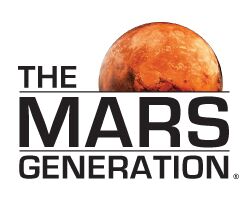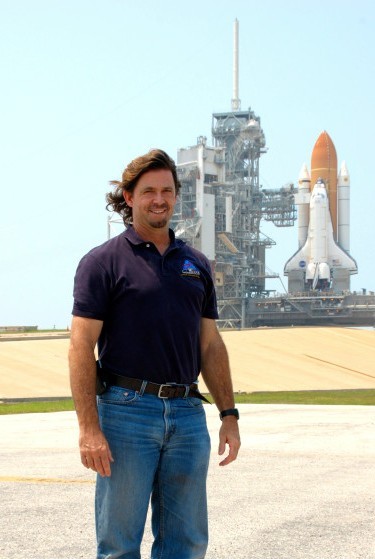Dr. Philip Metzger, Planetary Science Faculty, University Central Florida
Dr. Philip Metzger is with the planetary science faculty at the University of Central Florida. He recently took early retirement from NASA’s Kennedy Space Center, where he had co-founded the KSC Swamp Works. At the university, he is still part of the Swamp Works team and performs research and technology development related to solar system exploration and the settlement of space.
His work includes:
- Developing strategies to move industry off the Earth and into space, so we can relieve the environmental stress on the Earth without hindering continued economic growth of underprivileged peoples
- Developing robotic technologies to mine asteroids and the Moon and to do manufacturing in space
- Predicting how rocket exhaust interacts with Martian soil, and developing technologies to build landing pads on Mars
- Investigating the condition of ice deposits on the Moon
- Developing simulated meteorites and asteroid material for use in other research
- Developing CubeSats that can explore asteroids while replenishing their propellants from the asteroids themselves

Reduced Gravity Flight Tests: experiments of gas jets blowing soil in lunar and Martian gravity have identified the physical relationships that predict how much soil will be blown when landing on the Moon or Mars
While at NASA, he was part of the Space Shuttle launch team, later moving into the International Space Station program where he was on the organizing team for the Multi-Element Integrated Test, reputedly the largest test in aerospace history. Afterword he moved into technology development for Moon/Mars/Asteroid missions, where he was part of the In Situ Resource Utilization team, developing methods to use resources in space. He led the Agency’s work in rocket blast effects for human-class missions. He participated in architecture studies for the Lunar Architecture Team, the Mars Architecture Team and the Lunar Exploration Analysis Group, and he helped develop NASA’s technology roadmap for planetary surface technologies. He has also led projects to develop extraterrestrial excavators, regolith conveyance technologies, dust-tolerant quick disconnects, lunar/martian landing pads, and other surface systems technology. He co-founded NASA’s biannual Workshop on Granular Materials in Lunar and Martian Exploration and is a founding member of the ASCE Technical Committee for Regolith Operations, Mobility and Robotics.
Phil earned a B.S.E. (electrical engineering) from Auburn University in 1985, a M.S. in physics from the University of Central Florida in 2000, and a Ph.D. in physics from the University of Central Florida in 2005. His doctoral work focused on the theoretical statistical mechanics of granular materials with application to extraterrestrial soils.
He is a member of the American Society of Civil Engineers (ASCE) Granular Materials Committee, the ASCE Technical Committee for Regolith Operations, Mobility, and Robotics (ROMR), and the National Space Society. He co-founded the NASA/ASCE Workshops on Granular Materials in Lunar/Martian Exploration, and he convened a series of Workshops on Plume Effects in Lunar and Martian Exploration. He is also involved in numerous educational outreaches, including serving as a judge at the annual NASA Robotic Mining Competition for college students.

Dr. Metzger with his family at Jackson Hole peak.
Phil, his wife and four children live in Orlando, Florida and on Westport Island, Maine. He enjoys boating, kayaking, hiking, camping and collecting samples of sand both for research and as an excuse to spend time in nature.
Awards
In 2010, Phil was awarded the Silver Snoopy award from the NASA astronaut office for his response to events of Space Shuttle mission STS-124, ensuring the astronauts would be safe for landing. In 2011 he was selected as the Kennedy Space Center’s NASA Scientist/Engineer of the Year. In 2014 he received a NASA Silver Medal for Technology Development.
Publications
Some of Phil’s published papers include:
Affordable, Rapid Bootstrapping of the Space Industry and Solar System Civilization
Phenomenology of soil erosion due to rocket exhaust on the Moon and the Mauna Kea lunar test site
Apollo 12 lunar module exhaust plume impingement on lunar Surveyor III
Apollo video photogrammetry estimation of plume impingement effects
Estimation of Apollo Lunar Dust Transport using Optical Extinction Measurements
The Physical State of Lunar Soil in the Permanently Shadowed Craters of the Moon
Evolution of Regolith Feed Systems for Lunar ISRU O2 Production Plants
Electric Potential Due to a System of Conducting Spheres
Asymmetric electrostatic radiation shielding for spacecraft
Granular contact force density of states and entropy in a modified Edwards ensemble
ISRU Implications for Lunar and Martian Plume Effects
Jet-Induced Cratering of a Granular Surface with Application to Lunar Spaceports
Craters Formed in Granular Beds by Impinging Jets of Gas
Role of collisions in erosion of regolith during a lunar landing
Elegance of disordered granular packings: a validation of Edwards’ hypothesis



